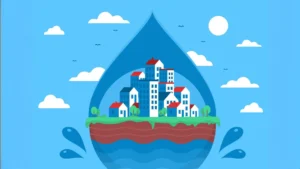India’s Urban Water Crisis: A Real Threat to Sustainable Development
India’s urban centers are hurtling toward an unprecedented water crisis. Cities like Bengaluru, Delhi, and Chennai are already grappling with acute shortages, and projections for 2030 paint a grim picture. Bengaluru, for instance, is expected to see severe summer scarcity, with dried-up borewells and a heavy reliance on private tankers Times of India, March 2024.
With 25 million new homes projected to be built by 2030 [KPMG via HDFC Proposal Brief], the built environment’s water demand will skyrocket. Yet, rainwater harvesting (RWH), a viable solution, is often treated as a compliance checkbox rather than an embedded design imperative.
Why? Because for most new-age real estate developers, RWH is difficult to design, hard to quantify financially, and tricky to implement within modern residential layouts.
The Demand for Water Positive Homes
Today’s homeowners are no longer passive buyers; they are active evaluators of sustainability. With monthly water tanker bills ranging from ₹2,000 to 4,000 per household The News Minute, 2024, residents are becoming wary of investing in properties that don’t promise water resilience.
The result? A rising demand for water-positive homes; those that have built-in rainwater harvesting, greywater reuse, and groundwater recharge mechanisms. Projects that fail to provide these are not only losing buyer interest but also seeing stagnation in price appreciation and sales velocity.
The Real Challenge for Developers: Designing Rainwater Harvesting Right
While mandates make RWH compulsory, the actual implementation is full of challenges:
- Lack of Integrated Design Tools: Most developers struggle to simulate RWH capacity, storage sizing, and recharge efficiency in relation to project specifics like roof area, rainfall, and occupancy.
- Site Constraints: Rooftop space often competes with solar panels, HVAC units, and amenities, making RWH layout planning complex.
- Surface Catchment Limitations: Surface-level harvesting requires large pervious areas and advanced filtration units, both of which are hard to accommodate in high-density urban projects.
- Fragmented Vendor Ecosystem: From filtration systems to storage tanks and recharge pits, finding quality-assured components and vendors is time-consuming and uncoordinated.
- No ROI Visibility: Developers struggle to calculate and communicate the long-term value of RWH to homebuyers—both in terms of operational savings and resale benefits.
The Smart Solution: Rainwater Harvesting by Design with SD+
Smarter Dharma’s SD+ platform tackles these hurdles head-on—transforming rainwater harvesting from a compliance task into a value-creating design feature.
For Rooftop Rainwater Harvesting:
- Custom Design Interventions: SD+ enables rooftop layout optimization based on local rainfall, roof slope, and usable area.
- Simulated Storage Sizing: The platform uses location-specific rainfall data to recommend optimal tank sizes and overflow mechanisms.
Impact Visualisation: Developers can instantly see how much water can be harvested, reused, or recharged—improving decision speed by 80%.
For Surface Water Harvesting:
- Permeability Analysis & Sizing: The system calculates how much stormwater can be captured from driveways, walkways, and open areas.
- Design for Filtration & Recharge: Integrated design support includes suggestions for filter chambers, sedimentation pits, and recharge trench layouts.
- Mandate Alignment: All designs are benchmarked against IGBC and RERA compliance needs.
And That’s Not All – SD+ Goes Beyond Design
- One-Click Access to Materials: Tap into a marketplace of 500+ vetted sustainable products, including filters, tanks, pipes, and recharge units, all in one place.
- Financial Modeling for ROI: SD+ shows CAPEX vs. OPEX savings, helping developers understand cost recovery timelines and lifetime value for residents.
Sustainability Reporting: Auto-generate reports for IGBC certification, SDG alignment, and investor briefings, all audit-ready and investor-friendly.
In an era where water availability defines urban living, rainwater harvesting is no longer optional—it’s essential. With Smarter Dharma’s SD+ platform, developers can seamlessly integrate rainwater harvesting into their projects, enhance buyer trust, and differentiate themselves in a crowded market.


